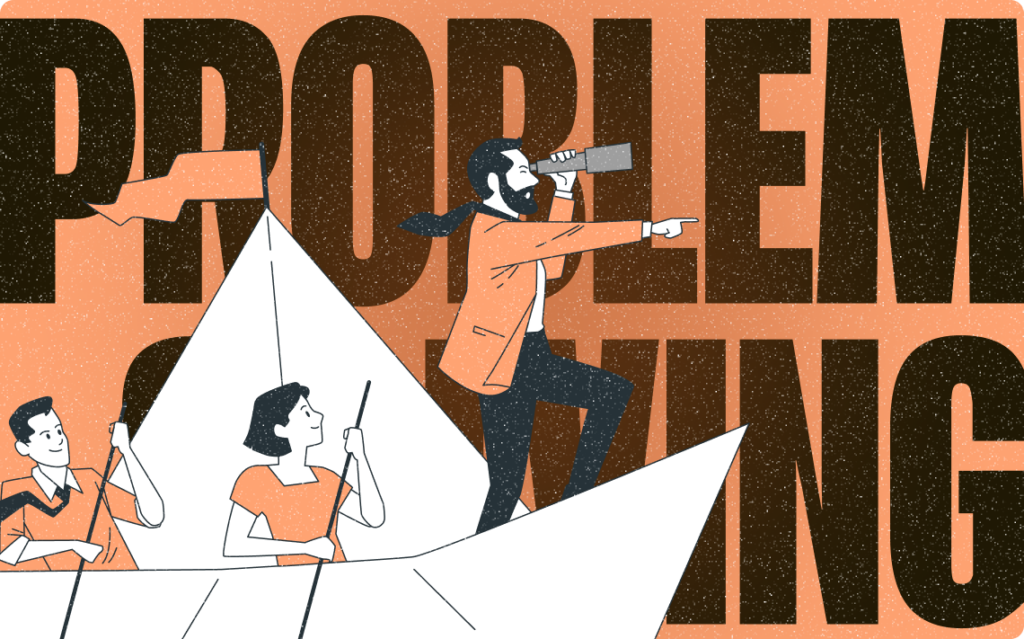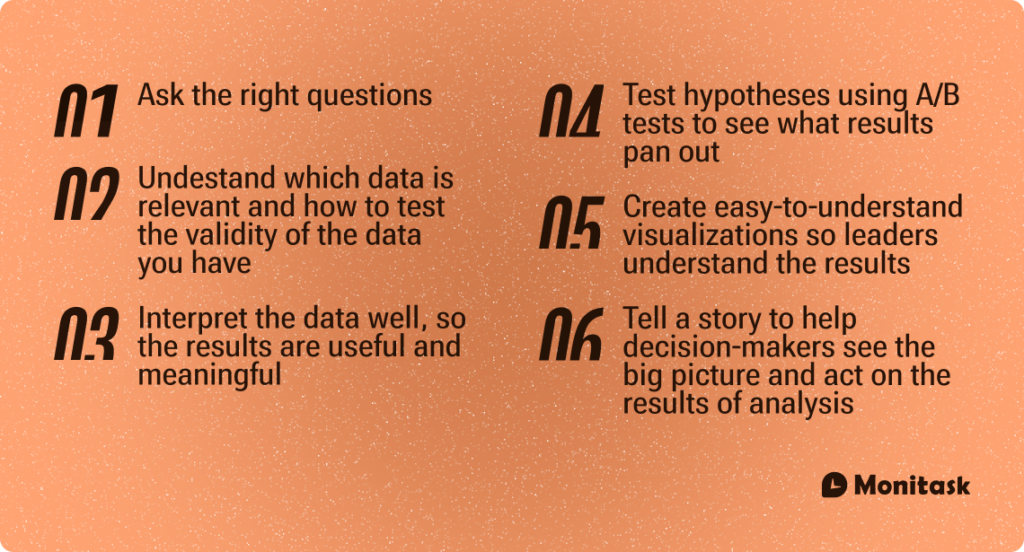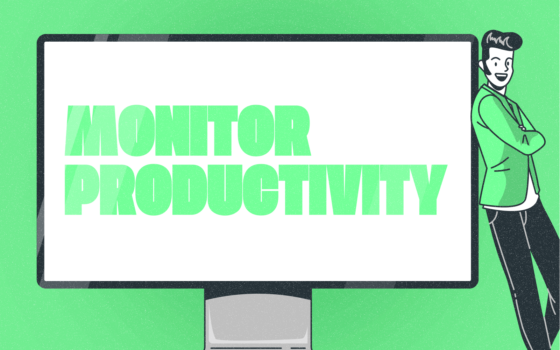How Leaders Solve Problems & Practical Strategies for Earning Your Employees’ Respect

When it comes to problem-solving, leaders are some of the best in the business. They have to be – their jobs depend on it! To succeed, leaders need to be able to identify and address issues quickly and efficiently. But problem-solving isn’t just a leadership skill. With the right approach, problem-solving can be taught and learned by anyone with the right attitude.
Whether you’re a leader or not, stay tuned as in this blog post, we will explore the most effective ways leaders solve problems. We’ll discuss different problem-solving techniques and how to apply them in your own life!

The Power of Leaders Who Focus on Solving Problems
Quite a title, eh? However, it’s not ours! We borrowed it from a great article by the Harvard Business Review written by Deborah Ancona and Hal Gregersen. This article features Vivienne Ming, an exemplary American theoretical neuroscientist, and AI expert who was honored as one of the BBC 100 Women in 2017.
In this article, we see a non-traditional perspective on leadership as Ming doesn’t see herself as a “top manager”, but rather as a “creative problem solver” which ultimately makes us think about a problem-led type of leadership. This article states that these leaders don’t expect people to flock towards them; rather, they want others to get passionate about the problem they have identified and come up with creative solutions.
“I get out there, and I solve problems. And I hope that motivates my colleagues to do the same.” – Vivienne Ming
This a very interesting stance since leaders can be seen as “the whole package”, but what if some leaders are only problem solvers, problem identifiers, problem advocates, and problem enablers? We like this perspective as it allows us to see and admire leaders in another light.
Then, how do these problem-led leaders solve issues? Keep reading to find out!

Solving Problems Like the Best Leaders: The Top Guideline
Usually, problem-led leaders have one rule: problem-solving must be collaborative. As a problem solver, the leader should involve everyone and anyone who has the knowledge and skills necessary. However, there are other steps problem-led leaders take to problem-solve effectively. Here, we’ll explore problem-solving techniques that problem-led leaders use to tackle issues, read on!
Find the Root of the Issue
The first step problem-led leaders take is to identify the root cause of an issue. This requires them to look beyond what’s visible and study the problem in depth. Leaders who do this can quickly come up with solutions that get to the heart of the problem, as opposed to those who settle for quick fixes or band-aid solutions.
This requires critical thinking, empathy, and collaboration to gain an understanding of the various pieces that make up a problem and how they interact with one another. Once we have identified these intricate details, then – and only then – can we begin to form effective solutions that will stand for long periods.
Frame the Problem Accurately
Problem-led leaders don’t only look at the problem, they also frame it accurately. This means they understand that each problem is unique and requires a different approach. Framing the problem accurately helps problem-led leaders hone in on their problem-solving skills, as they know which problem-solving techniques to use and understand the context of the problem.
Design thinking defines problem framing as defining the scope, context, and perspective of the problem

Problem framing is a process of problem-solving led by leaders. It has 5 distinct steps – problem discovery, business context, user perspective, business-to-user mapping, and problem framing.
- Problem discovery involves surfacing the problem for further analysis.
- Business context provides relevant context on the problem such as customer needs/goals and associated pain points.
- User perspective helps to understand users’ needs and goals through research.
- Business-to-user mapping bridges the gap between what the business can deliver and what the customer expects,
- And, finally, problem framing is designing solutions in response to problem discovery.
These steps are essential for problem framing to effectively turn ideas into visible and actionable products that provide value to end customers.
With all these steps, problem-led leaders guarantee that they are not only looking at the problem from their perspective but from the perspectives of those involved as well. By doing this, problem-led leaders can get a better understanding of different solutions and approaches to solving an issue.
Get more out of your business
Get the best employee engagement content every week via mailing list
Data-Based Problem Solving
Since the advent of big data, problem-led leaders have adapted and embraced problem-solving strategies that are data-driven. By leveraging their understanding of data, problem-led leaders can identify problem areas and develop solutions that are based on facts, rather than assumptions (Let’s not confuse assumptions with predictions or projections.)
This type of problem-solving technique involves gathering data from different sources, identifying patterns, and correlating data to gain valuable insights. For example, coming back to Vivienne Ming, she altered her diabetic son’s medical devices so that all their data could be compiled. With this new system in place, she created a predictive model that notifies her an hour before if any spike or decrease occurs in his son’s blood glucose level. Clever, eh?
Data helps us to accurately improve, tackling the exact issue we need to solve. Below, you have some skills for solving problems using data:

Yet, consider the following advice provided by Darrell Huff, author of “How to Lie with Statistics” when solving problems using data:
- High-quality, accurate, and up-to-date data is essential to achieve the desired results. If your data lacks any of these factors, it could cause unexpected outcomes.
- In a constantly shifting landscape or before an unexpected event such as COVID, data can become outdated swiftly.
- Relying solely on data may not be a dependable way to make decisions such as whether or not to maintain a continued business partnership.
- Data can be contorted ‒ either to the advantage or detriment of those involved ‒ to create a picture that doesn’t reflect reality.
Intuitive Problem-Solving
However, what happens when the data is not right? That’s when intuitive problem-solving can help leaders to figure out what is going on and the next steps they need to take. Intuition allows a problem-led leader to appreciate problem nuances and find solutions.
Intuition is not only about “gut” feeling; it is about problem-solving experience, problem familiarity, and problem context. Intuitive problem-solving requires a deep understanding of the problem at hand, problem-solving experience, and problem context. This type of problem-solving is essential when data fails or isn’t available.
Stay Open-Minded
Once problem-led leaders have taken the above steps, they need to stay open-minded by exploring different approaches and solutions to solving the issue. This means problem-led leaders don’t get stuck in the same thought process but instead seek out new ideas and perspectives.
By staying open-minded, leaders can access an array of possible solutions and be more adaptive to various situations. With no predetermined notions or expectations of the outcome, leaders can look at every angle involved and arrive at the best possible decision. Consequently, this approach leads to creative problem-solving, increased productivity, and improved leadership abilities.
Transparency is Paramount
Transparency is paramount when solving problems, as it allows everyone involved to come together and access different types of information to make well-informed decisions. Through transparency, leaders create space for a thorough investigation, collaboration, and constructive dialogue.
This level of transparency results in effective communication and stronger accountability systems, which ultimately lead to better decision-making. To ensure the success of any organization, transparency should be the go-to guiding principle commanded by its leader or leaders.
Stop Pointing Fingers
Not blaming anyone is an important philosophy for all leaders to implement. Taking ownership of a problem is the first step toward resolving it while pointing fingers and trying to blame others will only lead to more problems.
Leaders should instead focus on gathering resources and motivating their team members to discover solutions. Identifying the cause of the issue and properly utilizing resources is key to successful problem-solving.
Leaders need to take charge and think proactively about how best to move forward, rather than dwelling on finding someone to blame.
Communicate the Problem, the Solutions, and the Results
Clear communication of the process should be delivered at every step, from describing the problem to presenting solutions and outlining potential results.
Leaders must be succinct with their communication so that it is easily understood and prevents the risk of misinterpretation. By tailoring communication styles to fit the needs of their team, leaders can ensure understanding while inspiring confidence and motivation within their team in problem-solving initiatives.
Modify or Apply Solutions According to the Results
Leaders must shape or modify solutions according to the results they experience while problem-solving. A key part of leadership is being able to identify how results shape solutions and apply them in a thoughtful, effective way.
This requires the ability to weigh the evidence and use it to decide how best to shape or apply original solutions. Doing so empowers leaders to take decisive action and shape their solutions with confidence, leading teams toward success even amidst difficult challenges.
Monitor Solutions and Results
By consistently evaluating their process, leaders can recognize which strategies work and which ones don’t. This analysis allows them to make informed decisions that ultimately resolve any issues they may have.
Key Performance Indicators (KPIs) are a great way to measure problem-solving progress and results, as they help leaders identify problem areas and track their solutions. This allows them to determine problem-solving success, and modify their problem-solving strategies accordingly.
Leaders must remain mindful of the solutions and results, ensuring their continual performance are up to standard. With the help of monitoring, leaders can monitor and develop effective strategies, resulting in better problem-solving practices.
Prepare Yourself for Another Round
Thorough problem-solving should always come prepared with a plan to address issues that may arise again in the future. Leaders must be able to anticipate potential issues soon and develop problem-solving strategies for them.
It is important to anticipate future issues and construct problem-solving strategies for them. Creating an action plan to confront any forthcoming issues is key to remaining positive and getting through the process in one piece. Staying on top of the situation by continuing to stay prepared and ensure the best possible outcome is essential.

5 Practical Strategies for Earning Your Employees’ Respect in the Workplace
1. Lead by Example
Leadership is as much about behavior as it is about strategy. When you consistently act with integrity and professionalism, you set a high standard for your team to follow. This means being punctual, meeting deadlines, and showing dedication to your role.
- Demonstrate the work ethic you expect to see in your employees.
- Handle challenges with grace and resilience, showing that obstacles are opportunities for learning and growth.
- Be transparent in your decision-making processes, allowing your team to understand the ‘why’ behind your actions.
By embodying the qualities you value, you inspire your employees to emulate these behaviors, fostering a workplace where respect is a natural byproduct of exemplary leadership.
2. Communicate Effectively
Effective communication is the cornerstone of earning respect in the workplace. It involves not just talking but also listening actively to your employees’ ideas and concerns. This two-way street fosters an environment where everyone feels heard and valued.
- Be Clear and Concise: Avoid misunderstandings by expressing your thoughts and instructions clearly.
- Be Open and Accessible: Encourage open dialogue by being approachable and available for discussions.
- Practice Active Listening: Show that you value your employees’ input by listening attentively and responding thoughtfully.
By prioritizing clear, open communication, you demonstrate respect for your team’s contributions and establish a foundation for mutual respect.
3. Show Appreciation
Recognizing the hard work and achievements of employees is a powerful way to earn their respect. A simple ‘thank you’ can go a long way, but there are many methods to show appreciation that can have a lasting impact:
- Personalize recognition by acknowledging specific contributions.
- Celebrate milestones and successes, both big and small.
- Provide tangible rewards, such as bonuses or extra time off, to reinforce positive behavior.
Creating an environment where appreciation is regularly expressed encourages a positive workplace culture. It’s important to ensure that recognition is fair and consistent, so all employees feel valued. This not only boosts morale but also motivates your team to maintain high performance standards.
4. Foster a Culture of Trust
Fostering a culture of trust within the workplace is essential for building a cohesive and productive team. Trust is the foundation of all successful relationships, and this is particularly true in a professional setting. When employees feel trusted, they are more likely to take ownership of their work and go the extra mile.
To cultivate trust, transparency is key. Ensure that communication is open and honest, and that decisions are made with fairness and integrity. Here are some practical steps to foster trust:
- Encourage open communication and provide forums for employees to voice their concerns and ideas.
- Be consistent in your actions and follow through on commitments and promises.
- Protect confidentiality and show that you can be trusted with sensitive information.
- Empower your team by delegating responsibilities and showing confidence in their abilities.
By implementing these strategies, you can create an environment where trust thrives, leading to increased employee satisfaction and loyalty.
5. Provide Opportunities for Growth
Empowering your employees with opportunities for professional development is a cornerstone of a respectful and dynamic workplace. By investing in your team’s growth, you demonstrate a commitment to their future and the future of the company.
- Encourage Learning: Offer access to training sessions, workshops, and seminars that align with your employees’ career goals.
- Mentorship Programs: Pairing less experienced employees with mentors can provide guidance, knowledge transfer, and a clearer path to advancement.
- Career Pathing: Work with your employees to create individualized career paths that outline potential progressions within the organization.
Such initiatives not only foster a sense of loyalty and motivation but also help in building a more skilled and competent workforce. When employees see a clear trajectory for their career within the company, they are more likely to be engaged, productive, and respectful of the leadership that supports their ambitions.
Conclusion
Earning the respect of your employees is a critical component of effective leadership and a harmonious workplace. The strategies outlined in this article provide a roadmap for cultivating a respectful environment where employees feel valued and leaders are admired. By demonstrating integrity, practicing empathy, communicating effectively, leading by example, and recognizing the contributions of your team, you can establish a foundation of trust and respect that benefits everyone involved. Remember, respect is not an entitlement but a privilege that is earned through consistent and genuine actions. As you implement these practical strategies, you will not only gain the respect of your employees but also foster a culture of mutual respect that can propel your organization to new heights.
-The Monitask Team
Frequently Asked Questions
How can effective communication earn respect from employees?
Effective communication involves listening actively, being clear and concise, providing constructive feedback, and being open to suggestions from team members.
In what ways can a manager show appreciation to their team?
Managers can show appreciation through public recognition, personalized thank-you notes, rewards for outstanding work, providing professional development opportunities, and celebrating team successes.
Why is fostering a culture of trust important for gaining respect?
A culture of trust encourages transparency, reduces fear of taking risks, enhances collaboration, and shows employees that their contributions are valued, which in turn fosters respect.
What kind of opportunities for growth can a manager provide to earn respect?
Managers can offer mentorship programs, support further education or training, delegate challenging tasks, and create clear career pathways within the organization.
How does respect from employees impact workplace productivity?
When employees respect their leaders, they are more engaged, motivated, and committed to their work, leading to increased productivity and a positive workplace environment.


